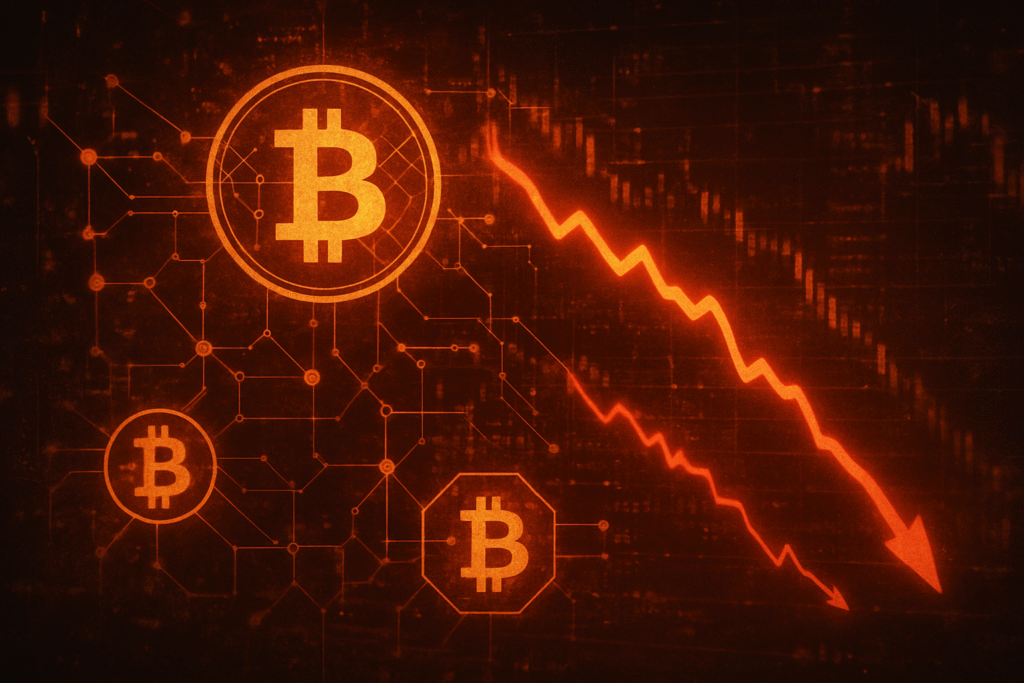Bitcoin Bloodbath: Retail Investors Face $17 Billion Loss Amidst Market Turmoil

The cryptocurrency market reeled from a devastating blow this past week, as a sharp downturn on October 10, 2025, wiped out an estimated $17 billion in long trading positions, primarily impacting retail Bitcoin investors. This dramatic plunge, which saw Bitcoin (BTC) plummet nearly 13% in a single hour—from $117,000 to $104,000—was exacerbated by escalating US-China trade tensions and new tariff policies. The broader crypto market capitalization shed over $600 billion in the days leading up to October 17, 2025, marking one of the most significant liquidation events in digital asset history.
The immediate market reaction was one of shock and widespread panic, with Bitcoin falling below $105,000, its lowest point since June of this year, after having reached an all-time high of $126,251 just days earlier on October 6. This event serves as a stark reminder of the inherent volatility and interconnectedness of the crypto ecosystem with global macroeconomic and geopolitical shifts. For the crypto ecosystem, this matters immensely as it underscores the fragility of speculative investments, the profound impact of global politics on digital assets, and the urgent need for retail investors to exercise caution in a market often driven by hype.
Market Impact and Price Action
The October 10, 2025, market crash unfolded with alarming speed and severity, leaving a trail of significant losses across the cryptocurrency landscape. Just days before the downturn, Bitcoin had soared to an all-time high of $126,251 on October 6, reflecting a period of intense bullish sentiment and speculative fervor. However, this euphoria was abruptly shattered on October 10 when, in a mere hour, Bitcoin's price plummeted by nearly 13%. The most intense phase of the drop saw BTC fall from $117,000 to $104,000 within approximately 20 minutes, representing a staggering 15% decline and triggering a cascade of liquidations.
This rapid descent continued, with Bitcoin's price falling below $105,000 by October 17, marking its lowest valuation since June of the same year. The sheer volume of assets wiped out was unprecedented, as the total crypto market capitalization shed over $600 billion in the week leading up to October 17. This included the liquidation of over $19 billion in trading positions, with a staggering $17 billion in long positions being obliterated, disproportionately affecting retail investors who had leveraged their bets on continued price appreciation. The event was widely characterized as the "largest liquidation event ever recorded in crypto," with an estimated $500 billion in total market capitalization vanishing within a 24-hour window.
The crash underscored the growing interconnectedness between traditional financial markets and the crypto sector. Concerns stemming from US regional banks and heightened geopolitical tensions, particularly the escalating US-China trade dispute, triggered a widespread "flight to safety" among investors. This capital reallocation away from risk assets, including cryptocurrencies, amplified the selling pressure. While specific technical support levels were breached with ease during the initial sell-off, the $100,000 mark for Bitcoin, once a psychological barrier for bullish sentiment, quickly transformed into a critical resistance level, highlighting the dramatic shift in market dynamics. The event serves as a stark parallel to previous periods of heightened global economic uncertainty, such as the March 2020 market turmoil, where traditional market anxieties rapidly spilled over into the nascent digital asset space, demonstrating the crypto market's susceptibility to broader financial shocks.
Community and Ecosystem Response
The sudden and severe market downturn on October 10, 2025, sent shockwaves through the crypto community, rapidly transforming an atmosphere of bullish euphoria into one of widespread concern and recrimination. Social media platforms, particularly Crypto Twitter and Reddit, became hotbeds of frantic discussion, characterized by a mix of despair from liquidated retail investors, calls for calm from seasoned traders, and renewed criticism from skeptics. Hashtags related to "Bitcoin crash" and "liquidation" trended globally, reflecting the immediate and visceral impact of the losses.
Crypto influencers and thought leaders, many of whom had previously championed Bitcoin's ascent to its pre-crash highs, found themselves in a difficult position. While some offered words of reassurance, emphasizing the long-term resilience of the asset and the cyclical nature of crypto markets, others faced backlash for what was perceived as overly optimistic predictions that may have encouraged risky leveraged positions. The rapid evaporation of over $17 billion in retail long positions led to a significant dip in investor confidence, evidenced by reported withdrawals from crypto ETFs. This shift in sentiment from optimism to extreme caution highlighted the fragile psychology underpinning the market, where narratives can shift dramatically in response to price action.
The broader crypto ecosystem also felt the ripple effects. While direct, real-time data on the impact on specific DeFi protocols, NFT projects, or Web3 applications is still being assessed, the general market contraction undoubtedly led to reduced liquidity and trading activity across these sectors. DeFi protocols likely experienced increased liquidations of collateralized positions, while NFT floor prices may have seen downward pressure as investors sought to de-risk. The event served as a stress test for the stability and robustness of various Web3 applications, prompting discussions on risk management, protocol resilience, and the need for more robust safeguards for retail participants in a highly volatile environment.
What's Next for Crypto
The October 10, 2025, Bitcoin crash, while immediately disruptive, has set the stage for a period of critical introspection and potential recalibration within the crypto market. In the short term, heightened volatility is likely to persist as the market digests the recent losses and investors grapple with renewed uncertainty. Retail investors, many of whom faced significant liquidations, are expected to remain cautious, potentially leading to reduced trading volumes and a slower pace of new capital inflow. However, the market has already demonstrated a degree of resilience, with Bitcoin showing a relatively swift rebound towards the $115,000 mark and Ethereum (ETH) regaining over $4,000 within days of the initial plunge, suggesting underlying buying interest and institutional support.
Looking further ahead, the long-term implications point towards a more mature, and potentially more regulated, crypto landscape. This crash will undoubtedly intensify calls for increased regulatory scrutiny, particularly concerning leveraged trading and investor protection. Governments and regulatory bodies are likely to push for clearer frameworks, such as the GENIUS Act for stablecoins and the CLARITY Act for digital asset jurisdiction, which, while potentially restrictive in the short term, could foster greater institutional confidence and mainstream adoption in the long run. Projects focused on robust fundamentals, real-world utility, and innovative technology, especially within the Decentralized Finance (DeFi) space and Real-World Asset (RWA) tokenization, are expected to garner more attention and investment, moving away from purely speculative ventures.
Potential catalysts for recovery and sustained growth include further regulatory clarity, which could unlock significant institutional capital. Macroeconomic factors, such as central bank interest rate decisions, will also play a crucial role, with rate cuts potentially encouraging investment in riskier assets like cryptocurrencies. Continued technological advancements, particularly in scalability and interoperability solutions, will enhance the utility and accessibility of blockchain networks. For investors, strategic considerations include embracing dollar-cost averaging (DCA), diversifying portfolios, and focusing on blue-chip assets like Bitcoin and Ethereum. Projects, meanwhile, must prioritize building strong products, fostering community engagement, and ensuring operational resilience to navigate future market shocks. While a V-shaped recovery is possible given crypto's history of dramatic bounces, an extended period of consolidation or a U-shaped recovery remains a highly likely scenario as the market absorbs the lessons from this recent downturn.
Bottom Line
The October 10, 2025, market crash serves as a potent reminder of the inherent volatility and speculative nature of the cryptocurrency market, particularly for retail investors. The estimated $17 billion loss in leveraged long positions underscores the profound risks associated with high-stakes trading, especially when compounded by external macroeconomic and geopolitical pressures. Key takeaways for crypto investors and enthusiasts include the critical importance of robust risk management, avoiding excessive leverage, and maintaining a long-term perspective rather than succumbing to short-term market euphoria or panic. The event highlighted that even blue-chip assets like Bitcoin are not immune to rapid, significant downturns driven by global events.
In the long term, this crash is likely to accelerate the maturation of the crypto market. While painful, such events often purge unsustainable leverage and foster a more discerning investor base. The increased interconnectedness with traditional finance means that external shocks will continue to influence crypto, necessitating a more integrated view of global markets. This will likely lead to a sustained push for clearer regulatory frameworks, which, paradoxically, could be a catalyst for broader institutional adoption and greater stability, albeit potentially at the cost of some speculative freedom. The resilience shown by the market in its relatively swift initial rebound also signals a growing underlying strength and institutional conviction that was not present in earlier market cycles.
Ultimately, the October 2025 Bitcoin bloodbath reinforces the foundational principles for navigating the crypto space: do your own research, understand the risks, never invest more than you can afford to lose, and consider dollar-cost averaging to mitigate volatility. Important metrics to monitor moving forward include institutional capital flows into crypto ETFs, progress on global regulatory initiatives (e.g., MiCA, GENIUS Act, CLARITY Act), macroeconomic indicators like inflation and interest rates, and the continued development of projects with genuine utility and strong fundamentals. This event, while a setback for many, is a crucial chapter in crypto's ongoing evolution towards a more integrated and mature financial ecosystem.
This article is for informational purposes only and does not constitute financial or investment advice. Cryptocurrency investments carry significant risk.
More News
View More




Recent Quotes
View More
Quotes delayed at least 20 minutes.
By accessing this page, you agree to the Privacy Policy and Terms Of Service.